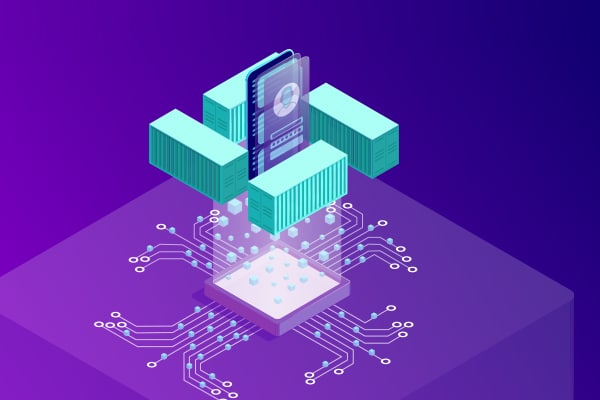Containerisation and Kubernetes have eased software development, making it faster and better. Let’s see where these are headed, looking at trends that are making life easier for developers.
Whether we’re using a banking app or watching videos, we expect all software applications to run smoothly, no matter what device or platform we use. Technologies like virtualisation and containers, and orchestration tools such as Docker and Kubernetes have restructured how applications are built, tested, and deployed. They make it easier for developers to create and run software consistently across different environments.
In the past, software development faced a lot of challenges—compatibility issues, scaling problems, and time-consuming deployment. These old methods often led to the well-known phrase, “it works on my machine,” when software didn’t behave the same way in different environments. As applications grew more complex with many dependencies and varying setups, finding more reliable solutions became essential.
Virtualisation, introduced in the 1960s, revolutionised computing by enabling multiple operating systems to run on a single machine. In the 2000s, containerisation was a significant development, with tools like Linux containers (LXC). The concept gained widespread attention with the launch of Docker in 2013, which made containerisation easier and more accessible for developers. Docker made it easy for developers to bundle applications and their requirements into portable containers. This allowed isolated environments to be easily deployed anywhere, cutting down the overhead that came with traditional virtual machines. Building on Docker’s success, Kubernetes arrived in 2014, created by Google to meet the need for managing containers at scale. With Kubernetes, developers gained powerful tools for automating the deployment, scaling, and management of applications, making software development even more efficient.
The origins: Virtualisation
Virtualisation started back in the 1960s when IBM introduced the idea of virtual machines (VMs). At that time, each computer could only run one task and one operating system (OS) at a time. If a company needed to run several programs, they needed a separate computer for each one, which wasn’t efficient. For example, if a business wanted to run both payroll software and inventory management software, they would need two separate machines, even if neither was fully utilising the computer’s resources.
Virtualisation changed all that. It allowed several OS instances to run on the same physical machine, helping companies use their hardware more efficiently. IBM’s System/360, launched in 1964, was one of the first computers to allow multiple users to share the same machine while keeping their work separate. For instance, a university could use the System/360 to run different programs for both administrative tasks and student research on the same machine without interference. This breakthrough laid the foundation for the modern world of cloud computing.
As the years went by, in the 1980s and 1990s, virtualisation kept improving. Advanced operating systems like UNIX helped create stronger virtual environments. As computers got faster and cheaper, more businesses began using virtualisation, especially with big mainframe computers. This made it easier to run several applications on fewer machines, saving money and making everything simpler to manage.
In the late 1990s and early 2000s, virtualisation saw a major shift with x86 virtualisation. This technology allowed personal computers to run multiple operating systems at the same time. Before this, only large and expensive servers could handle such tasks. But x86 virtualisation made it possible for even everyday computers with common processors (like Intel and AMD chips) to use this technology, making it more affordable and accessible to businesses and individuals. Companies like VMware developed software that made this process even easier. For instance, VMware’s product, VMware Workstation, enabled people to create and manage virtual machines (VMs) on their PCs. This was a game-changer because businesses could now test new applications, set up development environments, and create disaster recovery systems much more easily. For example, an IT department in a large company could use VMware to run both Windows and Linux environments on the same physical server. This allowed them to host their company’s website while also running internal payroll software on the same machine, saving both costs and resources.
However, VMs had their drawbacks. Each virtual machine needed its own operating system, which used up a lot of memory and processing power. This made VMs slow to start and resource-heavy. For example, starting a new VM could take several minutes, wasting valuable time. As businesses needed faster deployment times and more flexible applications, the inefficiencies of traditional VMs became more noticeable. Managing a large number of VMs was also tricky. Each one needed separate updates, security patches, and monitoring, which made it hard to manage them. As businesses grew, these limitations became clear, and there was a need for faster, lighter solutions.
Despite these challenges, the evolution of virtualisation from the 1960s to the 2000s was essential and paved the way for the next big development: containerisation.
Table 1: How virtual machines are different from containers
| Feature | Virtual machines (VMs) | Containers |
| Isolation | Full OS isolation: Each VM runs its own OS, creating a barrier between them. | Application-level isolation: Containers share the host OS kernel while remaining separate. |
| Resource usage | Heavy: Requires more memory and CPU because each VM needs its own OS resources. | Lightweight: Utilises minimal resources by sharing the host OS, allowing for efficient resource allocation. |
| Speed | Slow to start: Booting a VM involves starting an entire OS, which can take time. | Containers can start almost instantly because they share the host OS kernel. |
| Portability | Limited: Moving VMs between environments often requires compatible hypervisors and can be complex. | Highly portable: Containers can run consistently across any environment that supports the container runtime, making them easy to deploy and migrate. |
Containers: The game changer
Containers began to gain attention in the mid-2000s, particularly with the introduction of Linux containers (LXC) in 2008. However, it wasn’t until Docker’s launch in 2013 that containers became widely accessible and easy to use, benefiting everyone—from small startups to large enterprises. Docker offered a simple way to package software, including the code, libraries, and dependencies, into one container.
Think of containers like virtual machines, but much lighter and more efficient. Unlike VMs, which need their own operating system, containers share the same OS but keep the applications inside them isolated from each other. This makes containers faster to start; they use less memory, and are easier to move between different environments—whether it’s a developer’s laptop, a testing server, or even the cloud.
Docker made this process simple. It allows developers to ‘containerise’ an app, ensuring it runs the same everywhere. For example, an app built on a laptop using Docker can run just as smoothly on a server or in the cloud without any changes. This consistency is one of the main reasons containers have become so popular.
As Docker succeeded, a whole ecosystem of tools was built around containers. One of the most important tools is Kubernetes, originally developed by Google. Kubernetes helps manage containers at scale by automating the process of deploying, scaling, and maintaining them. If a company runs hundreds or thousands of containers, Kubernetes makes it easier to keep everything running smoothly.
One of the more innovative aspects of containers is their support for microservices. In microservices, an app is broken down into smaller, independent parts, each of which can be developed and managed separately. This makes app development faster and more flexible, as developers can quickly update or improve individual parts of an app.
Containers are also key in CI/CD (continuous integration/continuous deployment), a modern software practice that automates building, testing, and releasing software. With containers, developers can create consistent environments that make testing and deploying new versions of apps faster and more reliable. Another huge advantage of containers is their portability. This means apps run the same way no matter where they are deployed—on different computers, servers, or in the cloud.
Because containers make collaboration easier, they’ve also boosted the adoption of DevOps, a practice that brings developers and operations teams together. Containers, combined with DevOps, have made software development faster, more scalable, and reliable.
In short, containers have completely transformed how we build, deploy, and manage apps. They’re lightweight, quick to deploy, and can run anywhere. As technology continues to evolve, containers will remain a key part of the future of app development.
Containers vs virtual machines
While containers and virtual machines (VMs) both serve the purpose of isolating applications, it’s important to understand the fundamental differences between them. Table 1 lists these differences. This distinction is crucial for developers and IT professionals looking to choose the right technology for their needs.
One of the most significant advantages of containers is their ability to create a consistent environment for applications, regardless of where they are deployed. They encapsulate the application along with all its dependencies, libraries, and settings into a single package. This ensures that the application behaves the same way, whether it’s running on a developer’s laptop, a testing server, or in a production cloud environment. This level of consistency and reliability reduces friction in the development lifecycle and enhances collaboration among team members.
Kubernetes: Managing containers at scale
While Docker helps developers create and run individual containers, it becomes challenging to manage thousands of containers across multiple servers. That’s where Kubernetes (K8s) comes in. Developed by Google and released as an open source project in 2014, Kubernetes helps manage, scale, and automate the deployment of containerised applications.
Think of Kubernetes like an air traffic controller for containers. It oversees how containers are deployed, ensuring they are working properly, scaling up or down depending on how much traffic there is, and monitoring their performance. For instance, during a big online sale, Kubernetes can add more containers to handle increased website traffic and remove them when traffic decreases to save resources.
In modern software development, apps are often built using a microservices architecture, which means that different functions of an app are split into smaller parts, each running in its own container. Kubernetes helps manage these containers, making sure they communicate and work together smoothly, handling complex tasks like networking and load balancing. Here are some key features of Kubernetes.
Automated deployment and scaling: It automatically launches containers and adjusts their number based on real-time needs. For example, Amazon frequently experiences significant traffic spikes during major sales events. To prepare for these anticipated surges, Amazon utilises Kubernetes to automatically scale its services. Before the event, the company runs a baseline number of containers. As the sale approaches and traffic increases, Kubernetes intelligently adds more containers based on real-time demand, ensuring that the website remains responsive and capable of handling millions of requests per second.
Self-healing: If a container fails, Kubernetes automatically replaces it to keep the app running. For example, if a web application running in a container crashes due to an error, Kubernetes detects the failure and automatically creates a new instance of that container, ensuring that the application remains available and responsive to users.
Service discovery and load balancing: It assigns IP addresses and manages traffic so containers can communicate and perform without slowdowns. For example, in an e-commerce application, when a user accesses the site, Kubernetes directs their request to one of the available instances of the product catalogue service, ensuring efficient load distribution and minimal latency.
Storage orchestration: Kubernetes can connect containers to different types of storage, whether local or from cloud providers. For example, in a data processing application, Kubernetes can automatically provision and attach a cloud-based storage volume to a container, allowing it to store and retrieve large datasets efficiently without manual intervention.
Configuration management: It allows developers to manage the app’s settings without needing to rebuild the container. For example, a developer can update the database connection string for a web application stored in a Kubernetes ConfigMap, enabling the application to connect to a different database instance without redeploying the entire container.
As companies use cloud-based apps and microservices more often, Kubernetes has become the go-to tool for managing containers. It allows developers to focus on building new features while Kubernetes takes care of the hard work of managing and scaling the app. It makes it easier to manage containerised apps, helping ensure they run smoothly, grow as needed, and stay reliable. Kubernetes will continue to be important as software development advances, making app delivery faster and more efficient.
The impact on software development and DevOps
Docker and Kubernetes have changed how software is developed, especially how development and operations teams (DevOps) work together. DevOps is a movement that focuses on teamwork, automation, and making improvements throughout the software creation process. In the past, development (Dev) and operations (Ops) teams worked separately, which often led to confusion and delays. Docker and Kubernetes help by providing a common platform for smoother collaboration.
Docker allows developers to bundle everything an app needs—like code, libraries, and settings—so it works the same everywhere, whether on a developer’s computer or on a live server. This gives operations teams confidence when they deploy apps, knowing they’ll work without problems.
Automation is a big part of DevOps. By reducing manual tasks, it helps avoid mistakes. Docker and Kubernetes make it easier to build, test, and deploy apps quickly. As Kubernetes manages containers, teams can focus on creating new features rather than doing repetitive work. It also lets teams manage their infrastructure as code, making the deployment process more reliable.
These tools have also made CI/CD more popular. CI/CD allows developers to make and test changes to their code throughout the day, catching any issues early. Docker ensures that the environment stays the same across all stages, and Kubernetes manages the process of deploying apps consistently, reducing problems caused by different environments.
Using Docker and Kubernetes allows companies to release updates and new features in their apps more frequently. This helps businesses respond quickly to customer feedback, fix bugs, and stay competitive. Many companies, like Spotify and Airbnb, have improved their development and deployment processes by using these tools.
Current trends in containerisation and orchestration
Containerisation and orchestration are transforming how companies build, deploy, and manage software. Some significant trends are listed below.
Serverless architectures: Developers can now focus more on writing code without worrying about managing servers. This approach saves money because organisations only pay for what they use. For instance, Netflix leverages serverless computing to scale services efficiently during peak hours, such as when new episodes are released. This allows for rapid deployment and testing without managing complex infrastructure, making it ideal for fast-paced startups to quickly test ideas in the market.
Multi-cloud and hybrid cloud strategies: Companies are increasingly using multiple cloud providers to run their applications, avoiding lock-in with a single provider. For example, Dropbox uses a hybrid cloud strategy by combining public clouds like AWS with their private infrastructure. This approach helps them optimise costs, boost performance, and ensure better disaster recovery. If one provider experiences an outage, companies can quickly switch operations to another, maintaining continuity.
Edge computing: With the need for faster data processing, containers are now deployed closer to where data is generated, such as IoT devices. An example is Tesla’s use of edge computing in its self-driving cars. By processing data at the edge, these cars can make real-time decisions, reducing latency and enhancing the user experience. This trend is vital for applications requiring real-time responses, like smart city traffic systems and industrial automation.
Security in containerised environments: As container adoption grows, security has become a critical concern. Companies like JP Morgan Chase use specialised tools to scan containers for vulnerabilities, ensuring compliance with security protocols. For example, scanning container images for threats before deployment helps prevent compromised code from being executed. Additionally, monitoring containers in real-time allows for early detection of anomalies, enhancing security across distributed environments.
Container-native applications: These applications are built specifically for containers, often following a microservices architecture. Spotify, for instance, uses container-native applications to break down its services into microservices, enabling faster development, deployment, and scaling. This approach not only improves flexibility and resource efficiency but also ensures that the apps can run seamlessly across multiple cloud environments, providing a more robust and scalable infrastructure.
Each of these trends shows how containerisation and orchestration are pushing the boundaries of modern software development, allowing companies to innovate, scale, and secure their applications more efficiently.
The future of containerisation and Kubernetes
Containerisation is changing quickly, and several key trends are shaping its future alongside platforms like Kubernetes.
Automation and AI: Automation and artificial intelligence (AI) are changing how we manage containers. Smart systems can automatically adjust resources based on real-time demand. For example, when a cricket match is streaming, if there are many viewers, the system can allocate more resources to handle the traffic. Predictive maintenance tools can analyse system logs to predict failures. This means if a problem is detected, like a server about to crash, it can be fixed before it happens. Companies like Infosys use AI to monitor their systems, identify problems, and suggest solutions, reducing the need for human intervention.
Simplified developer experience: Making it easier for developers to use container technology is essential. New, user-friendly interfaces are being created so developers can manage containers without needing deep knowledge of Kubernetes. Platforms like Google Cloud offer tools that allow even beginners to deploy applications with just a few clicks. Low-code and no-code solutions are helping non-technical users, like small business owners, quickly develop applications without writing a lot of code. Improved documentation and community support also help people learn and adopt these technologies.
Security enhancements: As more companies start using containers, security is becoming more important. Tools like Open Policy Agent help enforce security rules throughout the lifecycle of a container. For example, if a school is using a cloud-based platform to manage student data, they need to ensure that only authorised users can access it. Real-time monitoring can detect unusual activities, like unauthorised access attempts. Automated vulnerability scanning can identify security risks before deployment, ensuring applications are safe.
To conclude, while Docker and Kubernetes are widely used, there are alternatives like Podman and OpenShift that cater to different organisational needs. Looking ahead, trends such as automation and AI will further enhance container management, making it easier and more efficient for developers. The growth of edge computing and serverless architectures will also create new opportunities for organisations to innovate and stay competitive.




